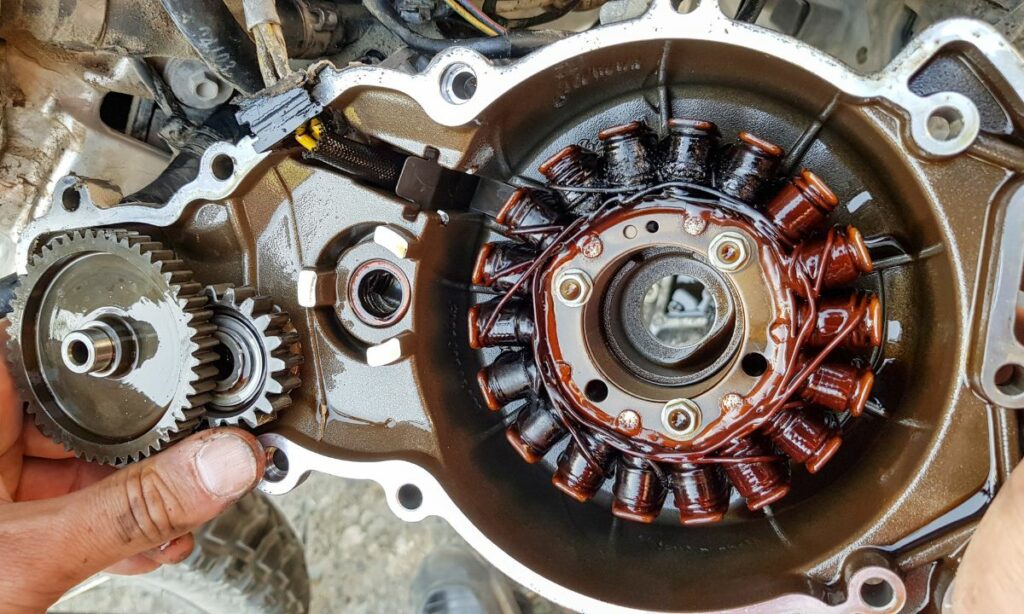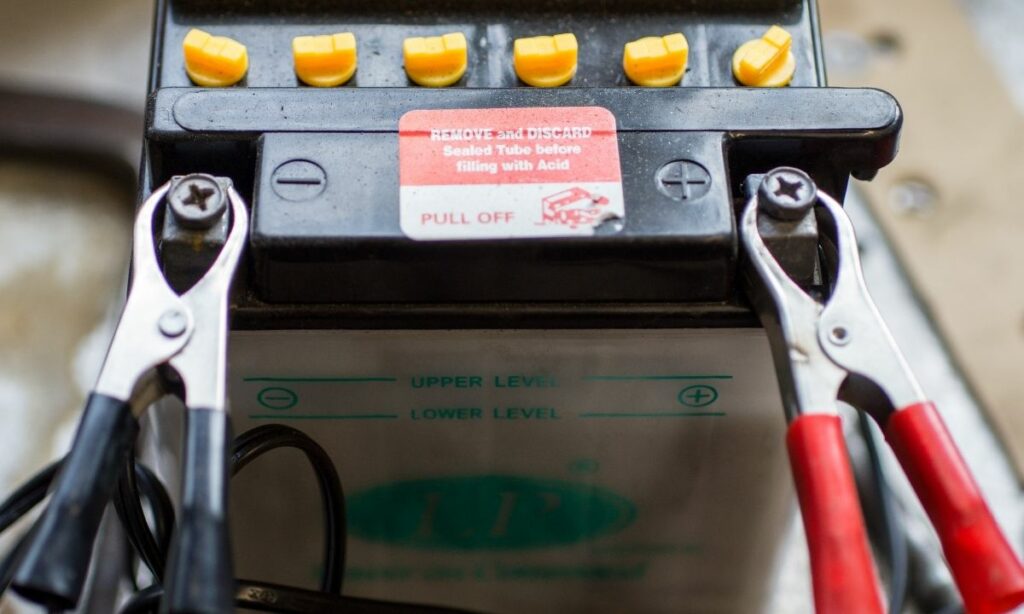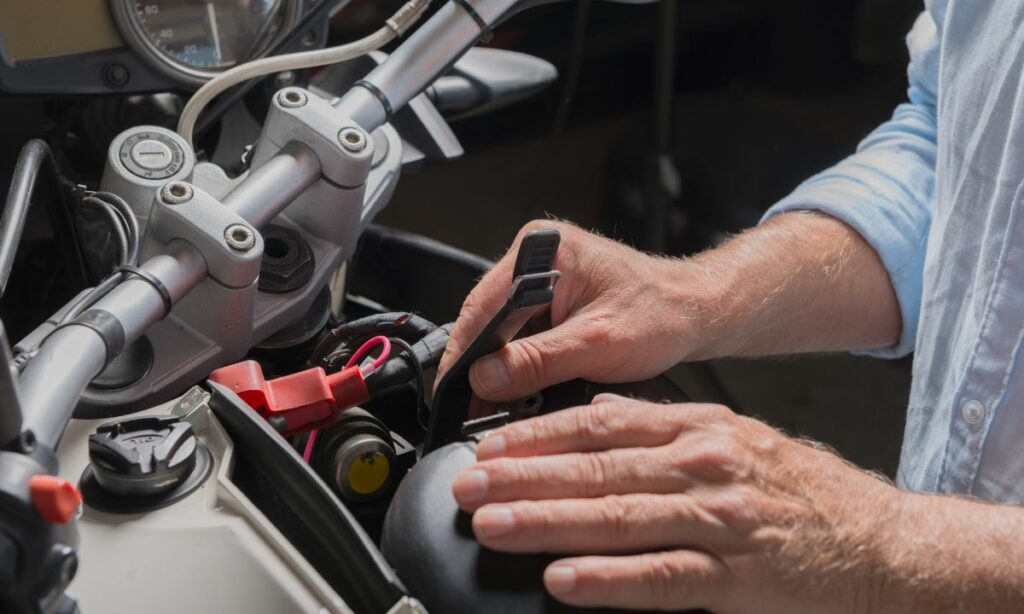The battery is an integral component of modern motorcycles. Without a functional battery, the motorcycle will not even start today.
That’s why, it’s vital to maintain a battery.
A constant question that comes to our mind (it did for me for a long time) is will the battery recharge itself in a motorcycle?
So, does a motorcycle battery charge while riding?
The battery gets charged in the motorcycle by deriving power from the engine. The alternator generates power and in conjunction with the regulator-rectifier supplies DC to the battery.
The battery recharge depends on the power requirements of the accessories in the bike and the alternator output derived from the engine.
Why is that? Let’s get into it.
Does the Battery get Recharged in a Motorcycle?
Yes. The battery does get recharged in a motorcycle. The alternator generates current derived from the engine crankshaft’s rotary motion.

The alternator generates current and is passed through the regulator-rectifier so that the battery receives DC (direct current) to charge up.
In short, the battery gets charged in a motorcycle.
However:
The battery is drained as well in the motorcycle.
The battery powers all electronic accessories. The headlight. Low beam. High beam. The backlight. The horn. Turn signals. Even the ignition.
It all depends on the power requirements of these accessories and the alternator output derived.
If the alternator output is more than the battery power requirements in the motorcycle, the battery gets recharged.
If the alternator output is less than the battery power requirements in the motorcycle, the battery gets drained.
There you have it. The battery gets charged as long as the power requirements of the motorcycle are lower than the power generated in the alternator.

But safe to say, the battery does indeed get recharged in a motorcycle by itself.
The Charging System – Alternator, Regulator and Battery
The battery along with the alternator and the regulator-rectifier forms the charging system in a motorcycle. To understand their roles clearly, here is a summarised description of the functioning of each of these components.
Alternator
The alternator in a motorcycle converts the mechanical energy – which is derived from the crankshaft through the engine – into electrical energy in the form of alternating current.

The AC current generated by the alternator will be proportional to the RPM of the engine. At higher RPMs, the rotor will rotate faster. Thus, the faster rotating magnetic flux will generate more electrical power.
Similarly, at lower RPMs, the rotor and hence, the magnetic flux rotation will be slower. The electrical power generated will consequently be lower as well.
Regulator-Rectifier
The regulator combined with a rectifier converts the alternating current (AC) generated in the alternator into direct current (DC).

Since the current produced by the alternator is AC and has varying voltages, the current cannot be passed on directly.
This is where the regulator comes in. The main functions of the regulator are – to convert the AC current coming from the alternator into DC (Direct Current), and to regulate the voltage of the alternator output.
Battery
The battery acts as the power source in a motorcycle. It provides current to the ignition system as well as supplies current to the accessories in the bike above the alternator output whenever required.

Since the alternator output has varying current outputs, the battery acts as the moderator. When there is excess current coming from the alternator through the regulator, the battery stores the excess charge.
Similarly, when there isn’t sufficient current generated by the alternator, the battery provides the deficit required for the accessories.
What Does a Battery Do in a Motorcycle?
Simply put, the battery in a motorcycle supplies current to power up all the electric accessories. This also includes providing current to the ignition system, i.e., to start a motorcycle you need battery power.

Now, the powering up of all the electric accessories in a motorcycle is not entirely reliant on the battery though. There is an alternator (also called a stator) that generates AC current derived from the engine running.
However, the AC (alternating current) generated by the alternator is not usable since the electric accessories require DC (direct current). That’s where a regulator (also called a rectifier) comes in to convert the AC into DC.
The AC generated in the alternator is converted into DC by the regulator. This converted DC is supplied to the electric accessories that require current and the excess is stored in the battery.
The electric accessories in a motorcycle that require current for their functioning are:
- Ignition
- Headlight
- High beam and low beam
- Fuel injection and fuel pump
- Turn signal indicators
- Brake light
- Horn
One key thing to note here is that the magnitude of alternator output is directly proportional to the rpm of the engine. So, the alternator output continuously fluctuates depending on the engine rpm.
Now, if the alternator output is less than the current required for all the electric accessories functioning, the battery provides the deficit charge. On the other hand, if the alternator produces excess current than required for the accessories, the excess charge is stored in the battery. That’s when the battery gets recharged.
Reasons for a Dead Battery in a Motorcycle
The reason why you are looking for whether the motorcycle battery can recharge itself in the bike is most likely because your battery is dead. Let us look at the various reasons why a battery is dead in a motorcycle.
Reasons for a dead battery in your motorcycle are –
- Poor Voltage Regulator: The Regulator basically converts the AC current output from the alternator into DC current that goes to the battery. If the Regulator is poor and is not performing up to the mark, the AC to DC current conversion is not proper – the battery will be impacted resulting in its death.
- Corrosion of battery terminals: Corroded battery terminals can be very problematic as the current will not flow easily. Add to it, there might be leakage problems as well in the battery that you need to worry about.
- Bad ground connection: The ground connection between the frame and the battery should be neat as an improper or poor ground connection will result in battery overcharging. The battery will not be able to pass on the excess charge from the alternator to the ground and will eventually malfunction due to overcharging.
- Short in the electric circuit: A short in the electrical connections might lead to severe problems in the working of different electrical components and might also fuse out the battery leading to your battery being dead.
- Heat and vibration: Excess heat and vibration will always have a negative impact on almost all the components. Battery is no exception. The lifespan of a battery is severely shortened when exposed to too much of heat or vibration in the motorcycle.
Tips for Battery Maintenance
Battery maintenance is an essential thing every rider needs to do especially since the modern motorcycle relies heavily on battery for optimal performance. Even to start a motorcycle, a battery is essential.
Even during motorcycle servicing, the battery needs to be checked whether it is in perfect condition or not. With that in mind, here are some of the tips for your motorcycle battery maintenance.
- Clean the outer layer and terminals of the battery regularly: Keep the top layer clean and wipe off the grime as frequently as possible. The frequency can coincide with the servicing frequency of your motorcycle.
- Check electrolyte levels if the battery is not maintenance-free: Nowadays, maintenance-free batteries are getting more popular with no intervention required for the user to check the electrolyte levels. However, if your motorcycle battery is not maintenance-free, you need to check the levels periodically.
- Tighten the battery caps: Check the battery caps for their tightness so that there is no possibility of any leakages. If the caps are loose, tighten it to secure the battery from any leakages.
Before you go…
Here are a few more motorcycle battery articles for you:
